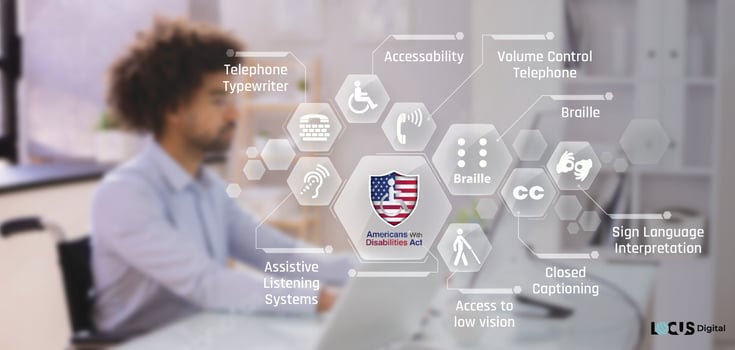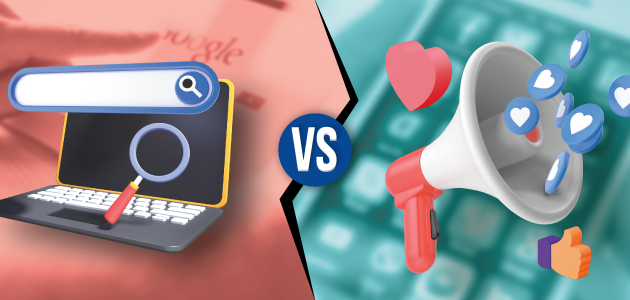Accessibility is Key: Why Your Site Should Focus on ADA Compliance

Accessibility is a hot topic in website design, but it's more than just a trend. There are a lot of reasons that your site should be focused on accommodating users with disabilities, but the ADA is one of the biggest ones.
If you run a business, you've probably heard about the ADA, otherwise known as the Americans With Disabilities Act. But what you might not know is that this law can have a major bearing on your website.
If you're not sure how the ADA is connected to your website, don't worry. In this article, we'll walk you through who it applies to, why it matters, and how you can ensure you are compliant.

What Is The ADA?
The Americans With Disabilities Act (also known as the ADA) is designed to help people with disabilities by promoting accessibility and prohibiting practices that are discriminatory. Through this important piece of legislation, accommodations for people with disabilities are ensured in many situations by law. For instance, the ADA often mandates that public spaces have handicap-accessible bathrooms and parking spots.
However, the implications of the ADA are not limited to workplaces, schools, and brick-and-mortar retail stores. We live in an increasingly digital age, and the government recognizes this. Many important tasks in our day-to-day lives are carried out virtually. Therefore, a failure to accommodate people with disabilities can only serve to restrict their ability to perform these same functions, which is a form of discrimination.
This is why this law has been updated so that it also extends to the internet. So this means that it's vital to make sure that your website is always ADA-compliant. Failure to do so can have numerous ramifications for your business.
What Websites Does the ADA Apply to?
Technically, the ADA is not applicable to everyone. There are only a few groups that must ensure that they meet the requirements of the Americans With Disabilities Act. These are:- All government offices at any level, from local to federal
- Businesses that are patronized by the general public
- Companies in the private sector that are staffed with 15+ employees
- Non-profits or charities that are staffed with 15+ employees
- Non-profits or charities that are designed to help the general public
So, it might seem clear who needs to worry about ADA requirements when it comes to in-person accommodations and practices. But you may be left wondering what this means for your website.
Well, because the ADA extends to the internet, the bottom line is that essentially every website should be made compliant with this law. At the very least, nearly all business websites will fall under the second category in the above list. However, even if it was not mandated for a specific company's site to be ADA-compliant, increasing the accessibility of their website will always be in a business's best interest.
Why Does ADA Compliance Matter?
To start, it's important for your website to be ADA-compliant because it is the law. Failure to meet the requirements of the Americans With Disabilities Act could subject your business to a sizeable fine. On top of that, once the Department of Justice gets involved, you may have legal fees and settlement costs to pay, as well as the price of updating your site so that it is compliant. Obviously, all of this is best avoided, so it's in every company's best interest to bring its website up to snuff.
However, ensuring that you meet accessibility standards is important in more ways than one. Not only will accommodating those with disabilities help you to avoid paying a large fee down the line, but it can actually be good for business too. After all, if more people are able to navigate your site with ease, that can only increase your possible customer base. So, by failing to reach compliance, you may actually be hurting your business's potential revenue.
What Does It Mean For A Website To Be ADA-Compliant?
When discussing one's web presence, ADA compliance can be understood to simply mean that the site is set up in accordance with the law. In practice, this can mean different things, depending on the features of the website. However, the end goal is going to be ensuring that each webpage is as accessible as possible for anyone, regardless of their disabilities or limitations.
Let's take a look at the Web Content Accessibility Guidelines (WCAG). The World Wide Web Consortium designed WCAG so that there could be a universal standard to increase virtual accommodations for those with disabilities across the globe. The 2.0 version of WCAG offers three categories that indicate varying levels of accessibility.
These levels are A, AA, and AAA, where AAA signifies that a site has the highest level of accessibility. A rating of AAA means that everyone should be able to browse a website without issues, whereas AA means most can, and A means only some can.
In general, when you're trying to bring your website up to the standards of the Americans With Disabilities Act, a WCAG grade of AA is sufficient. However, ensuring you reach level AAA can only further benefit your business and your customers.

What Does Website Accessibility Look Like?
There are a few different dimensions that should all be considered when you are attempting to make a website more accessible and/or ADA-compliant. After all, there are many different ways that people can struggle with engaging with a site. So, it's vital to take a holistic approach that ensures that everyone's disability is accommodated.
Accounting for sight impairments is a good place to start. If users have total or partial vision loss, navigating the internet may pose a challenge. Many of these people may use screen readers, which can help them to know what text is displayed on your site. However, these devices have limitations. For instance, screen readers can't read videos or images. Therefore, you should include "alt text" that describes this kind of content.
Relying heavily on colors can also be a problem. If you have a form that color-codes essential information, a screen reader will not be able to tell which text is in red and which is in green. Those that experience color blindness can also find this to be a barrier too.
There are other ways to promote accessibility as well. If your site includes video or audio elements, you should also ensure that there are clearly visible subtitles. This will serve to accommodate individuals that are hearing impaired. Some people may also have mobility issues that impact their ability to use a mouse or trackpad, so you should always ensure that your website can be navigated with a keyboard.
Plus, it's often not enough to merely include these kinds of accommodations, especially if they are hidden. Some users may not know how to toggle accessibility features. Therefore, you should always include instructions that use clear language in a prominent location. This is also a good practice for any part of your site. The easier you make it for users to understand your site, the better.
Also, even though some users will use tools and adaptive technology to browse your site, they are still deserving of the full experience. Therefore, you should never merely summarize in alt text or condense the site in any way. Access to all information should be granted to all individuals, regardless of the way they utilize it.
What's The Best Way To Make Your Website ADA-Compliant?
It's absolutely essential that your website is made to be as accessible as possible. However, if your current site lacks many basic accommodations, it can be daunting to bring it up to standard. Not only does this kind of revamp require some technical knowledge, but it can take a while too.
Fortunately, Locus Digital can help. Our expert team can help ensure that your website is fully compliant and reaches the highest level of accessibility. Working with us is a quicker and stress-free alternative to doing it yourself.
Plus, becoming ADA-compliant will save you money in the long run. You won't have to worry about fees or settlements in the future. Furthermore, when more people can comfortably and easily use your site, you're able to reach more people. That means that your potential sales increase too.
Ready to get started? Reach out to us today!


